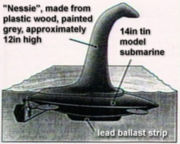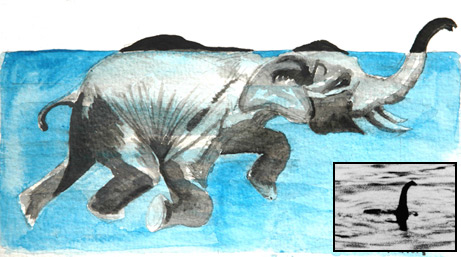
December 15, 2007

Adrian Shine, whom I understand is English not Scottish, was on NBC’s “Today Show” on Friday, December 14th. The guy almost sounded like a true believer from the Highlands. He was there to talk about the evidence for the Loch Ness Monster, and to promote the new movie, The Water Horse: Legend of the Deep, opening on Christmas Day.
Being part Scottish, I’ve always liked the name “Water Horse” for these critters, and used it a good deal in one of my cryptozoology field guides. I think the “Water Horse” theory makes a lot of sense, and I was delighted to hear this movie using this name was going to be made.
The movie, of course, is based on the book of the same title by Dick King-Smith. Adrian readily admitted the movie is for children, but as was obvious from his “Today Show” appearance, it gives an opportunity for all of us to talk about the reality of the Monsters of Loch Ness.
I only bring this up because I also had just read Darren Naish’s newest little contribution to cryptozoology, entitled “Really: photos of the Loch Ness monster,” over at his Tetrapod Zoology blog.
Well, of course, old buddy Darren has every right to be a debunker about these photographs, for it is the rare picture of a “monster” from Loch Ness that turns out to be anything of much worth to zoology.
However, I was surprised in one or two places in his essay, so I thought I’d mention a couple things.
First off, I have to take Darren Naish, the blogger, to task for not trying harder for some hits. He jokingly remarks: “In, as usual, a desperate effort to bring in the hits, I thought I’d go nuts and see what posting about the Loch Ness monster might do for my stats. Hey, maybe I could throw the word sex in there as well. There: sex, there, I said it again.”
What I immediately noticed about Naish’s blog is that he has not mentioned the new movie, Water Horse, which would have helped him get hits too. LOL.
But more amazingly, I can’t see one place in his blog where he calls this cryptid he is talking about by the more informal name, “Nessie.”
For Dr. Darren Naish, it’s “Loch Ness Monster” this and “Loch Ness Monster” that. 🙂 Doesn’t he know most people type in “Nessie,” when net searching, before they go looking for stuff on the “Loch Ness Monster”?
I’m kidding around a bit here, but there’s a scholarly skeptical side to my comments too. It reminds me of how Dr. Grover Krantz told everyone that Bigfoot would be seen as more credible if we all started calling them “Sasquatch,” exclusively.
Darren, next time try using “Nessie” for more hits, if that’s what you’re after.
As to the business about sex, well, I’ll get to that in a minute.
But now to some items of substance here.
Naish, who does not waiver in some of his declarations, writes: “The famous Rines-Egerton flipper photos (there are two) are undoubted fakes.”
The use of the word “fake” is a harsh one, as used by Naish. Fake tends to mean that someone was trying to put a hoax over on people. I’m not so sure that is what happened. Perhaps a mistake, an excited bouncing along with the evidence, or even a difference of interpretation? But an outright “fake”?
With reference to these flipper photos, Naish then soon writes: “Exactly who did the enhancing remains unknown so far as I know.”
How can this be? How can he not know? (Well, maybe he hasn’t lived and breathed cryptozoology 24/7 like I have for 50 years, and he has decided to have a life, ha ha.) Anyway, Naish sources Dick Raynor’s piece on the photos, and even there one can read what is commonly known, which is the photos were “enhanced at the Jet Propulsion Laboratory in Pasadena,” California.
If any enhancement blame is to be placed, it cannot fall to Rines and Egerton, but to JPL.
Next, I wish to make a couple points about Darren Naish’s treatment of the best known image of the Loch Ness Monster. This is the “photo” that, despite Adrian Shine being a Nessie skeptic, for example, still is used to get people to come visit Shine’s exhibition on the shores of Loch Ness.

I’m talking, of course, about the above image, the “Surgeon’s Photo” (even though there are two), which we usually see cropped, as at the top of this blog. It gets its name from Colonel Kenneth Wilson, who was known as the “Surgeon” because he had a medical practice in London.
The picture became famous as the “Surgeon’s Photograph” and is probably one of the most recognizable photographic images in the world – certainly within cryptozoology.
Of course, however, there were two photos (as below, uncropped):


Here’s what Naish writes about these photographs:
Easily the most iconic Loch Ness monster image is this one: the so-called Surgeon’s photo, or the Wilson photo. Taken in April 1934 by, supposedly, London-based gynaecologist Robert K. Wilson while he was on holiday, it shows a dark, erect-necked object surrounded by ripples. Analysis of the wave patterns around the object indicate that it is about 1.2 m tall (LeBlond & Collins 1987). Some people say that the photo was taken on April 14th, others say April 1st. The version we usually see of this photo is cropped: the original image – shown here – is much larger, shows the opposite shore of the loch, and makes the ‘monster’ appear much smaller. A second photo is supposed to show the head alone as the object is submerging, but it looks nothing like the famous first image and I see no reason to think they really were taken within seconds of each other as has been claimed.During the 1990s it was argued that the photo was a hoax perpetrated by Ian Wetherell and his stepbrother Christian Spurling using a toy submarine with a carved monster head mounted on its top (Boyd & Martin 1994, Martin & Boyd 1999). Wetherell was the son of Marmaduke Wetherell, the big-game hunter hired by the Daily Mail in 1933 to investigate the monster: he identified some footprints as having been created by the animal, but they were actually fakes made with a dried hippo’s foot. Wetherell senior then became fired for making such a rash mistake, and apparently planned to exact some sort of revenge. Wilson was co-opted as the alleged photographer because of his respectability, and agreed to be involved as he was ‘a great practical joker’. Some people have expressed scepticism about the Spurling and Wetherell story (e.g., Smith 1994, 1995, Shuker 1995, Bauer 2002) as there are various inconsistencies. Whatever the truth, I’m confident that the photo is a hoax and can’t take seriously the idea that it might depict a real animal.Darren Naish, “Really: photos of the Loch Ness monster.”

I don’t think its all this simple. Maybe the wave action did change during the taking of the four photos? Perhaps there’s a more mundane answer here? My problem with all of this business about it being a hoax, the toy submarine that has been as hard to show existed at that time as a Nessie, and all, is various details of this that are conveniently brushed aside.
First and foremost, let us return to sex. It seems rather obvious, even from material acknowledged in the highly debunking work, David Martin’s and Alistair Boyd’s book, Nessie: The Surgeon’s Photograph, there was an excellent reason the good Colonel Kenneth Wilson was not too open about the details of his holiday at Loch Ness. It appears he was there with a lover, and having an affair.
Yes, the sex has been taken out of the Loch Ness story, so let’s put it back in.
While authors have even been shy about giving forth with what Wilson said he was doing on the shores of Loch Ness – taking a break to urinate – perhaps he was doing something else? Maybe he was being, well, a sexual primate? And with the attractive person he was with? Talk about being placed in a compromising position while seeing a Lake Monster; Wilson must have not known what to do when he saw what he saw. When he snapped off the four photographs while on his secret adventure with his lover, this must have put him in quite a pickle. What to do? What to say? How much publicity do you think he really wanted? Why do you think it’s known more as the “Surgeon’s Photo” than “Dr. Kenneth Wilson’s Photo”?
Next, there’s the matter of ignoring what many of us have said about these photographs for a long time.
I must start with how Wilson talked about the animal he saw. He never said it was a “monster.” He was curious as to what it was, but seemed very careful to only mention it was only some kind of animal that he did not recognize.

My reading of the early opinion of this object, from zoologist Maurice Burton and others, was not that it was the head of some prehistoric animal, so much as the head of a water bird or the tail of a mammal diving into the water. I have said and written for years that the photo was never that important (other than as an icon), and probably was nothing more that the misunderstood image of the head or the tail of an otter.
Yes, folks, I think the “Surgeon’s Photo” is of an otter.
It is rather melodramatic to create all the involved storytelling of a deathbed confession (which never happened) and a toy submarine about images that may have more to do with the normal wildlife of the loch than hoaxing. Something about a razor mentioned by skeptics comes to mind.

I’m glad to read later in the comment section of his blog that Darren Naish has acknowledged that the “toy submarine” story itself is probably a hoax, and the “Loch Elephant” theory is silly.
For another good website on Loch Ness Monster or Nessie photos, from another skeptic, see: Tony Harmsworth’s Loch Ness Information Website
Skeptic cryptozoology can take into account that the photographic evidence from Loch Ness is horrible, but still retain the possibility of a small population of unknown animals who visit the lake from the ocean, overland, may have existed there for centuries. The water-kelpies and water-horses certainly may be very real.
About Loren Coleman
Loren Coleman is one of the world’s leading cryptozoologists, some say “the” leading living cryptozoologist. Certainly, he is acknowledged as the current living American researcher and writer who has most popularized cryptozoology in the late 20th and early 21st centuries.
Starting his fieldwork and investigations in 1960, after traveling and trekking extensively in pursuit of cryptozoological mysteries, Coleman began writing to share his experiences in 1969. An honorary member of Ivan T. Sanderson’s Society for the Investigation of the Unexplained in the 1970s, Coleman has been bestowed with similar honorary memberships of the North Idaho College Cryptozoology Club in 1983, and in subsequent years, that of the British Columbia Scientific Cryptozoology Club, CryptoSafari International, and other international organizations. He was also a Life Member and Benefactor of the International Society of Cryptozoology (now-defunct).
Loren Coleman’s daily blog, as a member of the Cryptomundo Team, served as an ongoing avenue of communication for the ever-growing body of cryptozoo news from 2005 through 2013. He returned as an infrequent contributor beginning Halloween week of 2015.
Coleman is the founder in 2003, and current director of the International Cryptozoology Museum in Portland, Maine.
Filed under Breaking News, Cryptomundo Exclusive, Cryptotourism, CryptoZoo News, Cryptozoologists, Cryptozoology, Lake Monsters, Loch Ness Monster, Movie Monsters, Photos, Reviews